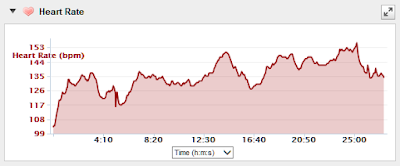A heart rate monitor that is reading, transmitting and recording properly looks like this:
 |
| HR recording as expected |
A heart rate monitor that does not have any skin-to-strap contact looks like this (no readings from 0 to around 4:30):
 |
| Heart rate reading when there no contact at the start of an activity. |
A heart rate monitor that is having a hard day looks like this:
 |
| Heart rate reading when contact is poor or intermittent at the start of an activity |
As a non-super hero, I cannot make my heart rate hit 250 beats per minute (bpm). In reality, since I wasn't scaling the side of a mountain when these readings were taken, my heart rate would have been on the same trajectory from 0:00 to 4:10, but my HRM was confused. Lack of good contact really throws off the average HR for the activity. In the grand scheme of things it's not a big deal, but when one has an HRM, one would want it to work correctly. Here is what I do to solve or at least minimize erratic heart rate readings.
Before I dispense my sage wisdom, I should share some of the "wisdom" I have heard. I have heard advice like "Don't wear technical fabrics.", or "Don't run near sources of electrical interference." I'm sure that this is offered by well-meaning individuals, but come on, if I go out for a long run in a cotton shirt, I will have no skin left on my torso by the time I'm done. IT's simply not an option. As for sources of electrical interference, unless I'm deliberately running in a elevator shaft or through a field of power lines and transformers, I probably can't detect electrical interference on my own, e.g. through the fillings in my teeth. There are probably other tidbits you have heard, but as the owner of many HRMs from different manufacturers over the years, here is what I know works:
1) Use electrode gel on the contacts. This is especially important in cool/cold weather because proper reading of heart rate signals depends on good contact between the contacts on the strap and your skin. Sweat is perfect for maintaining this contact, but when it takes a while to start sweating, you need a bit of help. (See the second and third graphs above.) This is where electrode gel comes in because it replaces sweat when sweat is a long time in coming.
It is available in medical supply stores and is relatively cheap. A large tube will last a couple of Canadian winters for me. Just apply a line across the length of each contact on the strap and brace yourself for the shock of cold gel hitting your skin. Don't despair; it warms up fast. This solves things in pretty much every situation.
2) Clean the contacts. Nothing fancy. Just use warm water and liquid dish soap. Sneak it in when you are washing dishes and let it air dry. If you have one of the premium straps, remember to remove the transmitter first. You need to clean the part of the strap that contacts your skin to read your heart rate. Washing the entire strap - the transmitter/contact part, and the elastic strap - has the added benefit of not driving family members and pets from the room when you pull it out of your gym bag.
3) Wet the elastic part of the strap. This will keep it from slipping until you start sweating. If the strap slips, contact between it and the skin can be broken. Warning: no matter what time of year it is, this will feel cold on your back. Brace yourself! That being said, it is well worth the shock. Having it slip and trying to fix it when you are wearing a bunch of layers is a royal pain.
4) Change the battery. If your unit is sealed, it should be replaced by a qualified technician; contact your device's manufacturer for help. If the battery is replaceable, you can replace the battery yourself. It is a cheap and easy way to help with troubleshooting. I have owned units from Polar, Garmin and TomTom. All have used the same lithium battery, the ubiquitous CR2032, which is available in a three pack at the dollar store. I could spend more on name-brand batteries, but I find they last well and I can buy a dozen or more of the cheap ones for the price of one name-brand.
I hope this helps you. I know full well that none of this is new; there are numerous sites and forums where you can find the same advice. I wrote this because I get asked about this a lot. If you have found anything else that works for you, please share it in the comments below.
No comments:
Post a Comment